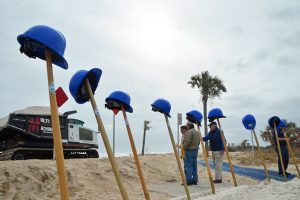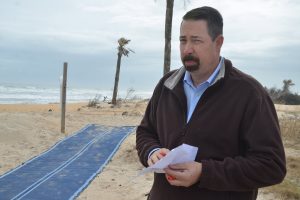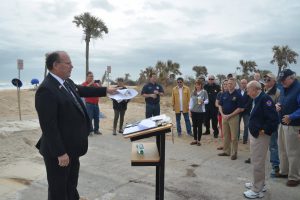
It took Hurricanes Matthew and Irma and a couple of lesser storms a matter of hours to demolish Flagler County beaches’ dune system.
It’s taken 15 months since Matthew to put together the $25 million necessary to start the repairs, money cobbled together from the Federal Emergency Management Agency, the state Department of Environmental Protection, homeowners, and a big loan from a local bank, secured by Flagler County’s tourist tax. It will take 48 weeks, nearly 1 million tons of sand brought in with 26 trucks making 100-mile roundtrips three to four times a day each, and workers putting in 50-hour weeks for the duration to rebuild the dunes.
Assuming another storm doesn’t wash out the works along the way.
That momentous rebuilding work began earlier this week, and Saturday, state, county and municipal officials, contractors, road and bridge workers and a handful of residents and sentinels of the Hammock gathered at the end of Malacompra Road, the location of the much-battered Malacompra Park, for a ceremonial ground-breaking of the project. After they spoke, officials lined up along a cream-white sand mound prepared for the occasion and twice shoveled up some sand in the air for the cameras.

(© FlaglerLive)
It’ll take the form of 6 cubic yards to 8 to 10 cubic yards for every foot of beach for 11 to 15 miles, with the dunes spreading from around 75 feet at the base to 25 feet at the top, at heights of 5 feet. (The difference in cubic yards reflects what each agency pays for: FEMA pays for thinner dunes, DEP for thicker ones.) It is nevertheless one of the largest projects of its kind ever undertaken on a Florida beach without the involvement of the U.S. Army Corps of Engineers. It entails the involvement of innumerable agencies and divisions of local government, as County Administrator Craig Coffey–the George Balanchine of it all–described it, from engineering to finance to legal to state and federal labyrinths, all the way to the bulldozer driver who’ll be shaping the dunes at a 5-to-1 slope for 10 hours a day, five days a week.

This morning, in any case, was an occasion for thanks.
“I want to say thank you to the public for your patience and strength to endure all these storms and hardships we’ve gone through,” Coffey said, “and know that your strength and your support has helped in supporting our boards, supporting our legislature, and lastly thank you in advance for helping us support and protect the dunes in the future, and help us promote dodge-the-dunes campaign, because we’ve got a lot of visitors, they don’t always understand what means to you, and to you guys it means protection, it means your lifestyle, it means tourism, it means a lot of things. But thank you everyone so much for all your support along the way.”
One absence stood out: though Palm Coast officials never hesitate to talk up their town’s benefits for its proximity to the beach and often as if it were, as its name incorrectly implies, on the beach, there was not a single Palm Coast official present, administrative or elected. The city often doesn’t take part in commemorative events where the light shines mostly on the county, though the reverse is not nearly as true. Flagler Beach City Commissioner Rick Belhumeur represented his town, and the sheriff turned out, as did all five county commissioners and the county’s two state legislators.
More money is not forthcoming from the current legislative session. But More money may be needed beyond the completion of this project. “We’re going to have to keep continuing to fight for these dollars,” Sen. Travis Hutson told the small crowd this morning, “because the next storm is coming, we don’t know when but it is coming, and we want to make sure that there’s a system in place for all of our beaches so that we continue to renourish these dunes, because it is very important.”
Hutson was unwittingly alluding to an undercurrent of at least potential futility in all this, given how rapidly it could all be washed away again. Officials are aware.
“I have interviewed two very smart Ph.d. people on beach erosion,” Commission Chairman Greg Hansen said, “and the thing that they made clear to me is that beach erosion is natural and you can’t stop it. It will gradually either accrete sand or lose sand but there’s nothing you can actually do physically other than hardening the dunes, like build a wall, that can actually stop it. But they both iterated that what we’re doing is critical, this dune rebuild is critical, because that will protect us from a hurricane. It will protect the homes and the land and people’s possession from a hurricane. If a hurricane is bad enough it may chew it up, and we might lose it, but it will do its job, and that’s protect the people and their property.”
Renner countered the notion of futility. “I don’t think after two storms you can declare it a futile exercise. It is an expensive exercise,” he said. “I suppose in the hypothetical there’s a point at which you do have to ask how much do you spend, but I think at this point we haven’t had storms here in years and years, decades. We happen to have had two in the last two years. So what happens in the future–is it another 10 or 20 years before we have a storm, is it next year? If we’re seeing storms every single year then that’s going to become an issue for discussion in how we build our homes and how we build our beaches, and there are other proposals out there.”

There may yet or even soon be another day when Flagler will tremble and fear the sea, but if a fear of futility is one undercurrent, so was a recurring sense of faith, or at least hope, in most of what was said this morning. Had an epitaph been written in this morning’s ceremonial sand, it would have been Jeremiah’s, which does not shrink from fear: “For I have placed the sand as a boundary for the sea, an eternal decree, so it cannot cross over it. Though the waves toss, yet they cannot prevail; Though they roar, yet they cannot cross over it.”
![]()
Watch Christopher Goodfellow’s drone shots of the work in progress, and keep up with the work at Goodfellow’s channel:





























mark101 says
All I can say, just putting sand down with NO barrier to hold the sand there is saying, good bye to the sand when another hurricane hits, ( I hope not and pray not ) but lets be real, sand by itself is no match for storm surge. But its better than nothing or a quick fix, and that’s how Flagler Country runs their business, a quick fix.
ps: a little tiny sea oat plants will need to remain un-damaged by people and water for them to do any holding power to handle every day high tides as they mature to adult plants.
Facts says
Just wondering out loud. Did 5he Hammock Beach Club sign an agreement with county?
Really says
We all want this.But, Realistically the attempt to stop the natural flow of sand due to tides,storms, Noreasters etc is futile and a waste of $$. More than sand is needed. Watched 7mm $$ in sand wash away on Jupiter Beach years ago. Good luck.
palmcoaster says
Well incoming storms are supposed to be worse that the one’s we just had…will be these 25 million washed away to sea soon again if no solid barrier built to contain the sand? Just wondering…
palmcoastpioneers says
‘…An Approach to a New City: Palm Coast…’
by Dr. J. Norman Young 1972
Prologue
It is self-evident that our earth is finite and that our population is growing. In ever increasing numbers, man must be sheltered, and the shelter, of course, must cover land. Transportation media to and from the shelter must cover land. Shops and service facilities must cover land. Who will say that land should not be cleared for at least these purposes, assuming an increase in population?
Proceeding from this starting point, we quickly arrive at the most sensitive area of environmental turmoil: making certain that when man clears and improves land, he simultaneously maximizes environmental integrity and maintains ecosystem continuity. thus being the challenges to us at Palm Coast. In our deliveration on the environment and ecosystems, as will be seen, much consideration has been given to both plant and animal life. Every attempt has been and shall be made to assure maintenance of al parameters of life cycles. Literature, both scientific and lay, is full of differing criteria with regard to protection for various plants and animals. In all candor, there is no way that all the sincere voices can be satisfied.
At Palm Coast, the preponderance of voices will have a city more satisfactory in the ecological sense than ever before anywhere. Neither perfection nor utopia will result…only the best that our talents, time, energies and resources can produce. At Palm Coast, given the fact of biological synergism, we do speak for plant life…and we do speak for animal…but most of all we speak for man.
Dr. J. Norman Young
Page 128
What follows is of necessity an all too brief discussioni of an approach to a new city. The brevity is unfortunate considering the scores of thousands of words appearing in out technical studies. It is our hope that the reader will gain at least a few insights into our thinking, our philogophy, our science. We only ask him to keep in mind the alternative to what we are doing with our land. It, as is certain with land ownership, our land has been sold to independent subdividers, each of whom built a fifty unit subdivision ( moe than the average builder in the U.S.) there would arise at the very least 5,000 different subdivisions– unplanned, unintegrated, uncoordinated, and without all our controls. Such an eventuality would clearly be unacceptable …typical of the American tragic city-building past. There is another alternative, to be sure. Do not build at all; but then how would the necessity of shelter be provided for the expanding population? In a book published recently, Housing Crisis, U.S.A. 1 ) P. Fried estimates that in a ten year period in the United States in order to replace inadequate housing and build the new housing needed by our expanding population, some thirty-one million new units are required. We estimate that less than two-thirds of that requirement will indeed be built. Worse. What happens later? Do we not build at all? One might as well prepare a dirge for America’s funeral.
Palm Coast will be neither a “sudden city’ nor an ‘instant’ one but will grow in accordance with a pre-planned program, no matter whether it flourishes twenty, thirty, or forty years from now. Palm Coast is a strip of la thirty miles long at its longest, ten miles wide at its widest, covering approximately are miles. It is a fact that under the controls we will institute, despite its being larger in extent than Detroit or Philadelphia, it will have a density of say, Beverly Hills, California. But more on this later.—————–> Palm Coast has about six miles of ocean front,<—————- approximately twenty miles on the Intracoastal Waterway, and will have significant man made water areas. Again, these will be reviewed in the main body of the text.
Now to a brief description of the terrain. Like other areas along the east coast of Florida, the property was formed
primarily by sand dunes that have been build up by the interaction of winds, waves, tidal cycles, and ocean currents. This continued accretion of land as a repetitive process has caused the creation of lagoons between the new dune and the existing land mass. It is from these lagoon that the present salt water lagoons and marshlands evolved.
Page 129
For those wanting to re/ad the entire manuscript – Google Boston College Digital Law Review and enter 'Palm Coast' and/ or Dr. J. Norman Young, ( The Father of Palm Coast Project ), the above will appear.
Layla says
This was no quick fix. Read the story again. Thank you.
r&r says
Mark101 is right.
Richard says
The BEST and ONLY benefits for this useless wasteful project are the jobs and income that it is providing to people, companies that own the equipment and those providing the material. There are two houses located on the beach shoreline that did NOT sustain any damage from either hurricane or any of the severe storms that we have had over the last few years. They are located at Painter’s Hill and have a seawall in front of each house. That says it all!
capt says
I agree with Mark101, sand will not protect us by itself and @ Richard “”have a seawall in front of each house. That says it all! ” so true Richard so true.
Marie M says
Why is Craig Coffey in charge of this project? The EPA..FDOT and army Corp of Engineers are MUCH MORE QUALIFIED. HOW MANY TONS OF SAND HAVE BEEN DUMPED ON THE BEACH SINCE MATTHEW. .1 AND A HALF YEARS AGO…I HAVE SEEN THE SAND COME AND WASH OUT..WASTE OF TIME AND MONEY. .THIS NEW DUNE PROJECT WILL BE DONE IN 12 MONTHS? GOOD LUCK..WE WILL GO THROUGH ANOTHER HURRICANE SEASON WITH NO SEAWALL IN NORTHERN FLAGLER BEACH AND BE TOTALLY VULNERABLE ONCE AGAIN. GOOD JOB!!!
r&r says
Does Coffey own the company that’s doing this?????????????????
Wishful thinking says
How ironic… “Mala compra” Spanish for ” BAD PURCHASE”… Need more be said….
An Honest American says
ARE YOU KIDDING ME! What did the ARmy Core Of Engineers propose for this erosion? If any of these decisions makers did their homework the erosion correction would be done like this. Out in Westhampton, Long Island the beaches had a tremendous amount of erosion. The only way this could be corrected, was to put JETTIES in perpendicular to the shoreline. These jetties prevented erosion and built up the beaches and prevented further erosion. We elect commissioners to represent us but it seems they like to burn our tax payer money and who is Greg Coffee to be the decision maker for the commissioners. You are burning twenty five million dollars of taxpayers money and when the next hurricane comes there goes all the pure sand washed out again along with the road and buildings at guess who’s expense. . PURE IGNORANCE..
Marie M says
Yes jetties do work…lived in new York and New Jersey. ..dump more sand..waste more money. WHY DOESN’T ANYONE REIGN IN CRAIG COFFEY? ??
Anonymous says
What a waste of money. No amount of money can stop mother nature. The rocks placed on the dunes before the hurricanes were tumbled around like marbles and the sand being brought in is going to go back out to sea like it has been doing for years and years and years. Craig Coffey needs to be fired, and every commissioner and representative who supported this needs to be removed from office. You can’t fix stupid. The reason it has not been tried anywhere else in the state is because others know this is not a fix—it is a waste! The dunes them self is not going to stop an angry sea–that has been proven! Building never should have been approved so close to the coast line and this is the price that is paid for stupidity. When this proves to not work, Coffey, Renner and Hutson should reimburse the tax payers from their pockets.
Richard says
@ An Honest American –
Yes, jetties do work BUT you won’t find many Flagler Beach residents that want their beaches filled with jetties every so many feet. However, there is a person named Dick Holmberg that had developed an underwater “jetty type” system that restores shorelines and missing sand. The powers at be here in Flagler called him an incompetent fool who had no idea how to professionally present his beach erosion system to the “smart intelligent” ones sitting around the table listening. So they bid him goodbye claiming he received $50,000 for a document filled with junk and voodoo. Here is his web site – http://www.erosion.com Two links worth reading are the Links Page – http://www.erosion.com/links.asp and the FAQ Page – http://www.erosion.com/faq.asp
Outsider says
I could have moved to the beach years ago, but didn’t want to deal with (pay for) constant repairs due to salt spray induced corrosion and obvious potential damage from hurricanes and storm surges. Now I’m still stuck paying for all the above because some people made short-sighted decisions. Short of spending billions of dollars on concrete sea walls, which are still occasionally overrun by tides and surges, the beach will continue to ebb and flow as it has done for billions of years. All responsibility and financial burden should fall precisely where it belongs: on the homeowners and their foolish insurance companies. I should not be forced to subsidize their ocean views.
Layla says
So many experts posting here. Wondering if you want to post your credentials and if you are interested in running for office? Didn’t realize we have so many!
Start Charging says
Start charging to use the beach. Beach badges! Charge 5 dollars a day or $500 dollars for a yearly. Let the people who use the beach fix the beach.
Marie M says
Layla what are your credentials. ..must work for Craig Coffey
Outsider says
Layla, I’m not so sure any credentials in anything other than maybe some rudimentary history are required to realize if the beaches washed away before, they will wash away again. There ya go; no PhD required.
Chris Sezonov says
I think there is a legal problem with all this work. It is the following:
The east side of A1A all along Flagler BEACH, IS ALL PRIVATE PROPERTY,
Every inch of the length of the road is split into property parcels, with individual parcel
numbers, and assessments. There are some exceptions where the property parcels are owned
By the city and/or leased by the city.
Why are these owners receiving millions of dollars and not pay for it?
Will the new property appraisals reflect all the work and money improvements ?
Layla says
Marie, I am a citizen who wants to save our beaches. We have listened to Flagler Beach fight over solutions to no avail. Without those beaches, we have no tourism Industry here. You all seem to be experts. I had no idea we had so many here.
Bob Z. says
The closer one is to the beach the higher ones property taxes are, and those higher taxes go a lot further than those collected close to US 1. If the properties on or near the beach were not there everyone would pay more to make up for the loss, and without a beach property values would fall as well.
johnx says
somebody had to step up and actually do something or just admit there was nothing to do. so i admire the local effort. relying on the federal government to do something was foolhardy. doubt it will last, though. most places that do this have a lot of revenue to support constantly doing dune replenishment simply because its good for tourism.
Marie M says
Stop the insanity. ..the beach is gone since Matthew. .Ms. Layla forget about tourism. We are not going to have a road pretty soon. The sand washes out as quickly as it is placed. I have seen it everyday. …do you want the pictures.
Will says
Actually they should prevent parking along the east side of the road. If they were serious about saving the dune that would at least slow down the erosion. Won’t even be considered though. I see people parked in the grass every day. The PD tries but they can’t stop everyone.
An Honest American says
Layla, Some of the people on this site have more common sense than Greg Coffee and all the commissioners heading this project.